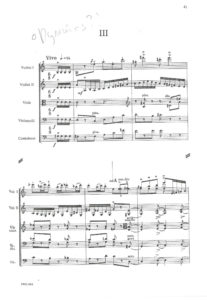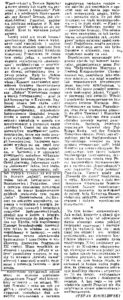- Concerto for String Orchestra, PWM score, mov. 1
- Concerto for String Orchestra, PWM score, mov. 2
- Concerto for String Orchestra, PWM score, mov. 3
In 1948 Grażyna Bacewicz composed a piece which became her “ninth symphony”. Although she would later write many other excellent compositions, Concerto for String Orchestra remains the Polish artist’s most frequently performed and most popular work. In a tribute published by Ruch Muzyczny after Grażyna Bacewicz’s death, Witold Lutosławski wrote:
“Concerto for Strings” is probably the highlight of that ‘no-nonsense’ period in Grażyna’s oeuvre which encyclopaedias simplistically refer to as ‘neoclassical’.
This “no-nonsense” approach, a characteristic feature of the composer’s style, is an important though not the only element of the Concerto, a piece of far greater complexity than encyclopaedic definitions might suggest.
The first movement (Allegro) is a combination of the Baroque concerto grosso formula (interdependence of the ripienoand concertino – solo violin and cello) and the early classical sonata allegro, still retaining many Baroque features. The main theme, which has become almost emblematic of the composer’s oeuvre – sweeping, based on pendular movement, with a fixed D4 basis (the beginning of the theme is in D Dorian) – although locked within the framework of periodicity, tends more towards motivic weaving rather than classic thematic work. This theme in the first violin is accompanied by a counterpoint in the cellos and double basses on a descending scale. From this counterpoint there emerge concertante fragments for solo violin. The second theme, although different in its structure, is just as lively, later becoming a smooth phrase. In the reprise the main theme is presented in G Dorian. In addition to the second theme, there appears, in a form shorter than in the exposition, a motif based on tremolos and serving as the third theme.
The second movement of the concerto (Andante) is an example of how Bacewicz was able to conjure up lyrical moods, harmoniously dispense emotions and feel a cantilena derived from the spirit of Romantic song. Against an almost monotonous background, based on a lullaby-like ostinato, of the ripienio created by the ensemble, the various voices of which play with different articulations, with frequent divisi in the various groups, there emerge solo passages of the cellos, violas and violins, usually with similar melodic formulas. Heightened expression in the middle fragment leads to a climax (ff) and then everything, like in a perfect A B A1 form, returns to the initial mood, disappearing in the final perdendosi.
In the third movement (Vivo), a cross between a rondo and a sonata, the composer returns to her favourite state of music understood as expansion of pure movement materialised in the form of themes-figures with unlimited possibilities of motivic transformations. The development of this movement is driven by a ritornello theme stylised from a folk dance, with characteristic irregular accents. On top of the motoric, broken pulse of this movement come episodes – antithetic in terms of expression and type of movement – like the one presented by a solo viola and then taken up by a solo violin. This may be the fragment about which Witold Lutosławski wrote:
I particularly like the dense, somewhat ‘bitter’ harmonies enveloping the secondary theme of the finale. Their flavour is especially vivid when compared with the austere, ‘empty’ chords which predominate in this score.
The Concerto was premiered on 18 June 1950 during a General Assembly of the Polish Composers’ Union. The Polish Radio Symphony Orchestra was conducted by Grzegorz Fitelberg. Soon the composer received the State Prize for the work. Reviews, including foreign ones, which generally were enthusiastic, contained allusions to the composer’s gender. Stefan Kisielewski, a friend of the composer, wrote in Tygodnik Powszechny (9 July 1950):
It can be said in all honesty that the honour of Polish composers was saved this time by a woman, Grażyna Bacewicz. Her “Concerto for String Orchestra”, written with panache and energy, full of smooth invention and brilliant instrumentation ideas, finally stirred us from our lethargy. The piece draws on some Bach or Handel – a modern “Brandenburg Concerto”, as it were. We finally got a ‘red-blooded piece’ of wholesome and delicious music written with a creative power that is truly virile.
- Fragment of a review of Concerto for String Orchestra by Stefan Kisielewski (Tygodnik Powszechny, 1950)



